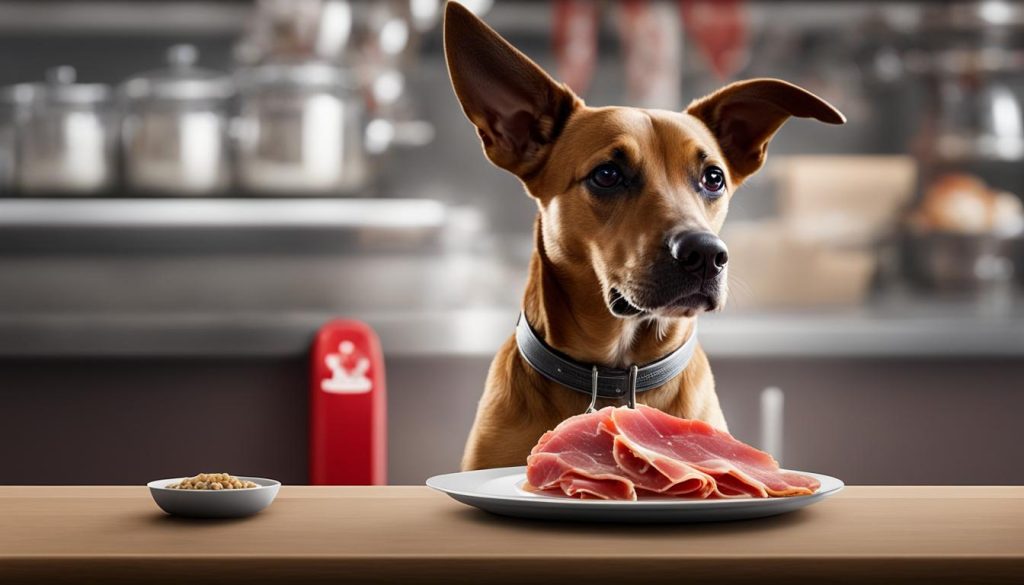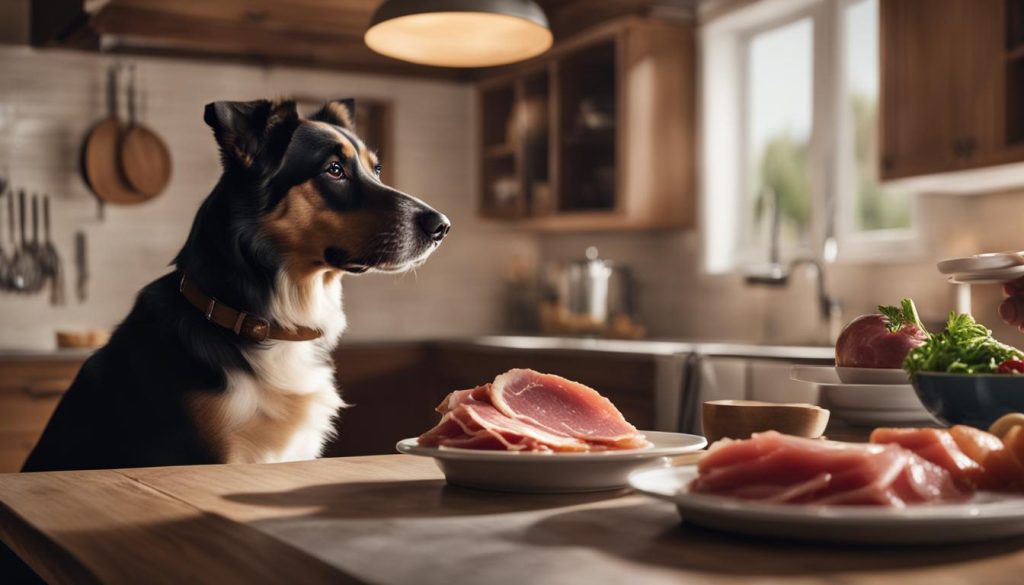Prosciutto, or Italian ham, is a popular cured meat that many people enjoy. However, when it comes to feeding prosciutto to dogs, there are some important factors to consider. While small amounts of prosciutto may not be harmful to dogs, it is generally not recommended as a regular part of their diet. Prosciutto is high in salt and fat, which can be detrimental to a dog’s health. Additionally, cured meats like prosciutto can be a potential source of bacteria such as listeria, which can cause foodborne illness in dogs. It is best to consult with a veterinarian before feeding any kind of cured meat to your dog.
Key Takeaways:
- Prosciutto is generally not recommended as a regular part of a dog’s diet due to its high salt and fat content.
- Cured meats like prosciutto can contain harmful bacteria and may cause foodborne illness in dogs.
- Consultation with a veterinarian is important before introducing any kind of cured meat to your dog’s diet.
- Safe and healthy alternatives to prosciutto include lean, cooked meats such as chicken or turkey, and vegetables and fruits like carrots and apples.
- A balanced diet, specifically formulated for dogs, is essential to their overall health and well-being.
The Risks and Health Concerns of Feeding Prosciutto to Dogs

Feeding prosciutto to dogs can pose several risks and health concerns. One of the main issues is the high salt content in prosciutto, which can lead to dehydration, electrolyte imbalances, and even sodium poisoning in dogs. This is especially concerning for dogs with underlying health conditions such as kidney or heart disease.
In addition to the high salt content, prosciutto is also high in fat. Excessive fat consumption can contribute to weight gain and obesity in dogs, which can lead to a range of health problems such as heart disease, diabetes, and joint issues. It is important to note that the fat content in prosciutto is much higher than what is recommended for a healthy dog diet.
Furthermore, prosciutto is a cured meat and can potentially contain harmful bacteria such as listeria. These bacteria can cause serious foodborne illnesses in dogs, leading to symptoms like vomiting, diarrhea, and lethargy. In severe cases, it can even result in organ failure or death. It is crucial to prioritize your dog’s health and avoid exposing them to unnecessary risks by not feeding them prosciutto.
The Risks of Feeding Prosciutto to Dogs:
- High salt content can lead to dehydration and sodium poisoning.
- Excessive fat consumption can contribute to weight gain and obesity.
- Potential exposure to harmful bacteria like listeria.
To ensure the well-being of your dog, it is best to avoid feeding them prosciutto altogether. Instead, opt for safe and healthy alternatives that provide the necessary nutrition without the risks. Lean, cooked meats like chicken, turkey, or lean cuts of beef can be suitable options. However, it is important to remove any bones and excess fat before serving them to your dog.
To summarize, prosciutto can be harmful to dogs due to its high salt and fat content, as well as the potential presence of harmful bacteria. Feeding prosciutto to dogs puts their health at risk and can lead to various health issues. It is best to consult with a veterinarian to create a balanced diet plan for your dog and choose safe alternatives that meet their specific nutritional needs.
Safe and Healthy Alternatives to Prosciutto for Dogs
Feeding prosciutto to dogs can pose risks to their health due to its high salt and fat content. However, there are several safe and healthy alternatives that you can consider to satisfy your dog’s taste buds. Lean, cooked meats such as chicken, turkey, or lean cuts of beef can be excellent options. These meats can be prepared by boiling, baking, or grilling without the use of added fats or seasonings. Remember to remove any bones and excess fat before serving them to your furry friend.
In addition to lean meats, incorporating vegetables and fruits into your dog’s diet can provide them with essential nutrients. Carrots, green beans, and apples are dog-friendly options that can serve as a nutritious addition to their meals. However, it’s essential to introduce new foods gradually and monitor your dog for any adverse reactions.
| Alternatives to Prosciutto for Dogs | Nutritional Benefits |
|---|---|
| Lean, cooked chicken | High-quality protein source |
| Lean, cooked turkey | Rich in essential vitamins and minerals |
| Lean cuts of beef | Good source of iron and zinc |
| Carrots | Provide fiber and vitamin A |
| Green beans | Low in calories and high in fiber |
| Apples | Contain antioxidants and vitamins |
Remember, a balanced diet is crucial for your dog’s overall health and well-being. Therefore, it’s best to consult with a veterinarian to ensure you are meeting your dog’s specific nutritional needs. They can provide personalized recommendations based on your dog’s age, size, and any existing health conditions. By choosing safe and healthy alternatives to prosciutto, you can give your furry friend a delicious and nutritious diet.
The Importance of a Balanced Diet for Dogs
Feeding prosciutto to dogs can pose risks to their health and well-being. To ensure your dog’s optimal health, it is crucial to provide them with a balanced diet that meets their nutritional needs. Dogs require a combination of proteins, carbohydrates, fats, vitamins, and minerals to thrive. While small amounts of prosciutto may not pose an immediate threat, it is not a suitable source of nutrition for dogs.
Prosciutto is high in salt and fat but lacks the essential nutrients that dogs need. A diet high in these ingredients can lead to obesity, digestive issues, and other health problems. Feeding prosciutto or any other type of human food as a primary diet can also result in nutritional deficiencies. It is best to stick to a complete and balanced commercial dog food that is specifically formulated to meet your dog’s nutritional needs.
A balanced diet promotes your dog’s overall well-being, including healthy skin and coat, strong immune system, proper growth and development, and increased energy levels. It also helps prevent chronic diseases and supports their longevity. Consultation with a veterinarian is crucial in determining the best diet plan for your dog, as they can assess their individual needs and provide expert guidance and recommendations.
| Nutrients | Role | Sources |
|---|---|---|
| Protein | Building blocks for muscles, tissues, and enzymes | Lean meats, fish, eggs, legumes |
| Carbohydrates | Main source of energy | Whole grains, vegetables, fruits |
| Fats | Energy source, absorption of fat-soluble vitamins | Fish oil, flaxseed oil, chicken fat |
| Vitamins | Support various body functions | Fruits, vegetables, supplements |
| Minerals | Regulate bodily processes, maintain strong bones and teeth | Meats, dairy, whole grains |
The Role of Veterinarian Consultation in Feeding Dogs
When it comes to feeding dogs, seeking guidance from a veterinarian is crucial. Veterinarians have the knowledge and expertise to provide the best advice based on your dog’s specific needs and dietary requirements.
Before introducing any new food to your dog’s diet, it is important to consult with a veterinarian. This is especially true when it comes to feeding prosciutto to dogs. A veterinarian will be able to evaluate the risks and benefits and provide recommendations for suitable alternatives if necessary.
In addition to assessing the potential health risks associated with prosciutto consumption, a veterinarian can also help create a balanced diet plan that meets your dog’s nutritional needs. They can consider your dog’s age, size, activity level, and any underlying health conditions to ensure optimal health and well-being.
Regular check-ups and consultations with a veterinarian are important in maintaining your dog’s long-term health. By working closely with a trusted veterinarian, you can make informed decisions about your dog’s diet and provide them with the best possible care.
| Benefits of Veterinarian Consultation in Feeding Dogs | Reasons to Consult a Veterinarian |
|---|---|
| Expert advice based on your dog’s specific needs and dietary requirements | Assessing the risks and benefits of feeding prosciutto to dogs |
| Recommendations for suitable alternatives to prosciutto | Creating a balanced diet plan for optimal health |
| Considering your dog’s age, size, activity level, and any underlying health conditions | Regular check-ups and consultations for long-term health |
Signs of Prosciutto Toxicity in Dogs

While small amounts of prosciutto may not be immediately toxic to dogs, it is important to be aware of the signs of prosciutto toxicity. If a dog consumes a large amount of prosciutto or if they have an underlying health condition, they may experience symptoms such as vomiting, diarrhea, excessive thirst, increased urination, lethargy, and in severe cases, seizures or pancreatitis. These signs may indicate that the dog’s body is reacting negatively to the prosciutto and that immediate veterinary care is necessary.
To properly evaluate whether prosciutto has caused toxicity in dogs, it is important to provide the veterinarian with detailed information about the dog’s exposure to prosciutto, including the amount consumed and the time of ingestion. The veterinarian will then conduct a thorough examination to determine the extent of the toxicity and provide appropriate treatment. It is crucial not to delay seeking veterinary care if you suspect that your dog has consumed a toxic amount of prosciutto.
Remember, prevention is always better than cure when it comes to the health and well-being of our furry friends. It is best to avoid feeding prosciutto to dogs altogether to minimize the risk of toxicity and other potential health problems. Instead, opt for safe and healthy alternatives that are specifically designed to meet the nutritional needs of dogs. Consulting with a veterinarian can provide valuable guidance and ensure that you make informed decisions about your dog’s diet.
Through proper education and proactive measures, we can keep our dogs safe and healthy, steering clear of potential dangers like prosciutto. By prioritizing their well-being and following professional advice, we can enjoy the company of our four-legged companions for many years to come.
General Guidelines for Feeding Dogs

Feeding your dog a proper diet is essential for their overall health and well-being. When it comes to feeding dogs, there are some general guidelines to keep in mind to ensure they are getting the nutrients they need:
1. Balanced Diet
It is important to provide a balanced diet that meets your dog’s nutritional needs. Commercial dog food that is specifically formulated for their age, size, and activity level is a convenient and reliable option. These dog foods are designed to provide all the necessary nutrients in the right proportions. It is best to consult with your veterinarian to determine the appropriate type and amount of food for your dog.
2. Moderate Treats
Treats can be a great way to reward and train your dog, but they should be given in moderation. Treats should not exceed 10% of your dog’s daily caloric intake. Too many treats can lead to weight gain and nutritional imbalances. Choose healthy, dog-friendly treats that are low in salt and fat. Avoid giving your dog table scraps or human foods, including prosciutto, as they may not meet their specific dietary requirements and can pose health risks.
3. Consultation with a Veterinarian
Before introducing any new food to your dog’s diet, it is important to consult with a veterinarian. They can provide expert guidance based on your dog’s specific needs, health status, and dietary requirements. They can evaluate the risks and benefits of feeding prosciutto or any other human food to your dog and recommend suitable alternatives if necessary. Regular check-ups and consultations with a veterinarian are crucial in ensuring your dog’s long-term health.
By following these general guidelines, you can ensure that your dog receives a balanced and nutritious diet that supports their optimal health and well-being. Remember to consult with a veterinarian for personalized advice and recommendations for your furry friend.
Training and Behavior Considerations for Feeding Dogs

When it comes to feeding dogs, it’s important to consider not only their physical health but also their behavior and training. Establishing consistent feeding routines and using positive reinforcement techniques can help encourage good behavior around food. Additionally, it’s essential to address any underlying training or behavior issues that may impact a dog’s eating habits. Seeking the help of a professional dog trainer or behaviorist can provide guidance and support in addressing these concerns.
Dogs are unique individuals with their own preferences and dietary restrictions. Some dogs may have specific allergies or sensitivities that need to be taken into account when selecting their food. It’s crucial to carefully read labels and ingredients to ensure that the food you choose is safe and suitable for your dog. If you have any concerns or questions about your dog’s specific dietary needs, consulting with a veterinarian can provide valuable insight and guidance.
“Establishing a positive feeding experience is crucial for a dog’s overall well-being. By creating a calm and peaceful environment during mealtime, we can help reduce anxiety and promote healthier eating habits.”
Feeding Prosciutto: Potential Training and Behavior Challenges
Feeding dogs prosciutto or any other high-value, human food can present unique challenges in terms of training and behavior. Dogs have a strong sense of smell and are often tempted by the aroma of these delicious treats, which can make it difficult to establish boundaries and reinforce good behavior. It’s essential to set clear rules and boundaries when it comes to feeding and to be consistent in enforcing them.
One common challenge is begging behavior. If a dog has been given table scraps or treats in the past, they may learn to associate mealtime with begging and become persistent in their requests for food. To address this behavior, it’s important to establish a routine feeding schedule and avoid giving in to begging. Instead, provide appropriate and nutritious treats during designated training sessions or as rewards for desired behaviors.
Feeding dogs prosciutto can also create expectations and reinforce negative behaviors, such as jumping or snapping for food. It’s important to address these behaviors promptly and consistently to prevent them from escalating. Working with a professional dog trainer or behaviorist can provide valuable guidance in addressing these challenges and establishing a positive feeding routine that promotes good behavior and a healthy relationship with food.
Key Considerations for Feeding Dogs
When it comes to feeding dogs, there are several key considerations to keep in mind:
- Establish a consistent feeding routine to promote a sense of security and predictability.
- Use positive reinforcement techniques to encourage good behavior around food.
- Address any underlying training or behavior issues that may impact a dog’s eating habits.
- Choose food that is appropriate for your dog’s specific dietary needs and restrictions.
- Avoid feeding high-value, human foods like prosciutto, as they can create behavioral challenges.
- Seek guidance from a professional dog trainer or behaviorist if you encounter difficulties or have concerns.
By considering these factors and prioritizing your dog’s training, behavior, and overall well-being, you can create a positive feeding experience and promote a healthy relationship with food.
Wrapping Up
To summarize, when it comes to feeding prosciutto to dogs, it is important to prioritize their health and well-being. While small amounts of prosciutto may not be immediately toxic, it is generally not recommended as a regular part of their diet.
Prosciutto is high in salt and fat, which can be detrimental to a dog’s health. It can also contain harmful bacteria, posing a potential risk of foodborne illness. Additionally, prosciutto lacks the essential nutrients that dogs need for a balanced diet.
Consultation with a veterinarian is crucial before making any changes to your dog’s diet. They can provide expert advice based on your dog’s specific needs and recommend suitable alternatives to prosciutto. It is best to stick to a commercial dog food that meets their nutritional requirements and provide safe and healthy alternatives for treats.
By prioritizing your dog’s well-being and following the guidance of a veterinarian, you can ensure that they lead a happy and healthy life without the need for prosciutto in their diet.
FAQ
Can dogs eat prosciutto?
While small amounts of prosciutto may not be harmful to dogs, it is generally not recommended as a regular part of their diet due to its high salt and fat content.
What are the risks and health concerns of feeding prosciutto to dogs?
The high salt and fat content in prosciutto can lead to dehydration, electrolyte imbalances, sodium poisoning, weight gain, obesity, and potential bacterial contamination.
What are safe and healthy alternatives to prosciutto for dogs?
Lean, cooked meats like chicken, turkey, or lean cuts of beef, as well as vegetables and fruits like carrots, green beans, and apples, can be suitable alternatives to prosciutto for dogs.
Why is a balanced diet important for dogs?
Dogs require a combination of protein, carbohydrates, fats, vitamins, and minerals for optimal health. Prosciutto lacks essential nutrients and can contribute to nutritional deficiencies.
How important is veterinarian consultation in feeding dogs?
It is crucial to consult with a veterinarian before making any changes to your dog’s diet. They can provide expert advice based on your dog’s specific needs and dietary requirements.
What are the signs of prosciutto toxicity in dogs?
Signs of prosciutto toxicity in dogs may include vomiting, diarrhea, excessive thirst, increased urination, lethargy, seizures, or pancreatitis. Immediate veterinary care is necessary.
What are general guidelines for feeding dogs?
Provide a balanced diet with commercial dog food that meets their specific nutritional needs. Treats should be given in moderation, and human foods should be avoided or given sparingly.
Are there training and behavior considerations for feeding dogs?
Training and behavior can impact a dog’s eating habits. Consulting with a professional trainer or behaviorist can address any underlying issues and promote a healthy relationship with food.
Can dogs eat prosciutto?
While small amounts of prosciutto may not be immediately harmful, it is generally not recommended as a regular part of a dog’s diet. Prioritizing their health is important for their overall well-being.






